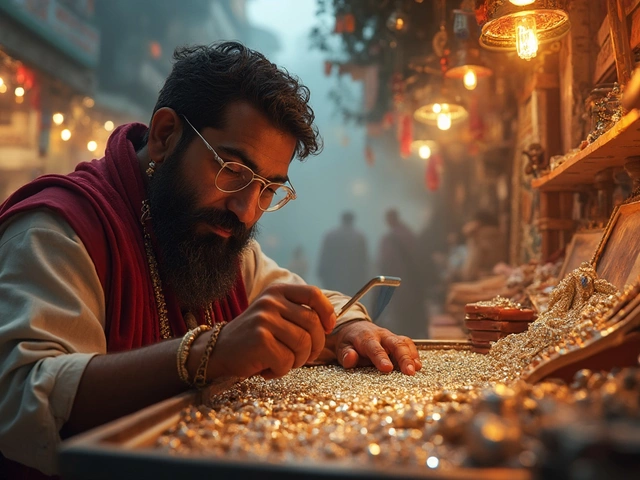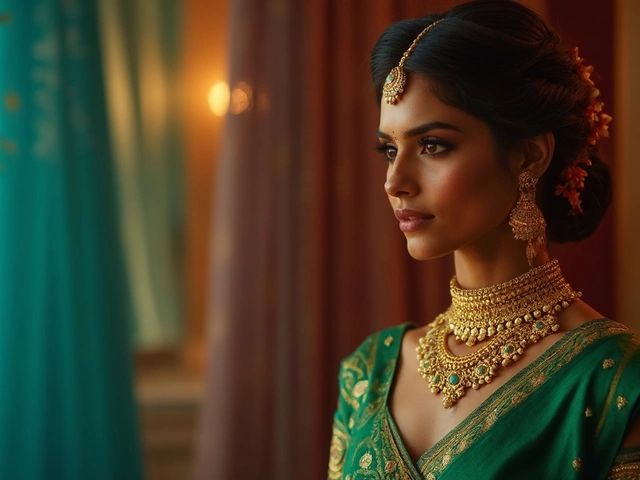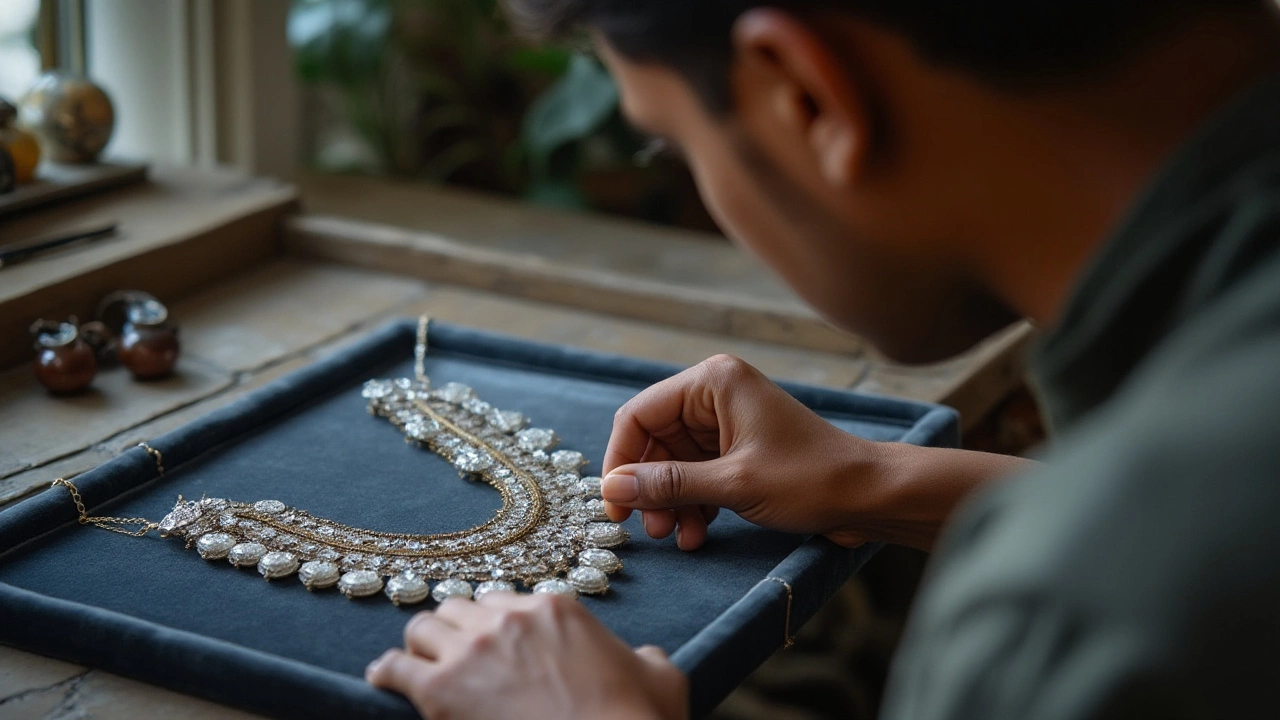
Antique jewelry is more than just adornment; it's a piece of history that can tell stories of the past while potentially increasing in value. For those with an eye for style and a head for investment, understanding the nuances of antique pieces is crucial.
Certain pieces, whether marked by famous makers or crafted from coveted materials, are well-known to appreciate over time. Recognizing these treasures requires knowledge of various eras, from the intricate detail of Edwardian pieces to the bold Art Deco designs.
Gemstones also play a significant role in the valuation of antique jewelry. Natural rubies, sapphires, and emeralds often grow in value, especially those with rare colors or exceptional clarity.
When considering an investment in antique jewelry, examining its historical context and appeal is essential. Timeless designs not only captivate onlookers but also tend to hold or improve their market standing.
As with any market, trends in antique jewelry fluctuate. However, with the right insights, investors can position themselves well ahead of shifts, ensuring their collections appreciate beautifully in both splendor and value.
- The Allure of Antique Jewelry
- Historical Pieces with Lasting Value
- Gemstones and Their Rising Worth
- Timeless Designs that Captivate
- Market Trends and Future Investments
The Allure of Antique Jewelry
There's something mysteriously captivating about antique jewelry, a charm that transcends mere aesthetics and taps into the depths of history and personal narratives. These exquisite pieces are timekeepers, each carrying whispers of the past, which often fuels collectors' passion. The allure of antique jewelry lies in its uniqueness, a quality that mass-produced modern pieces can't replicate. Each item, whether a delicate Victorian locket or a bold Art Deco bracelet, tells its own tale crafted by the hands of skilled artisans, making them the perfect embodiment of time, culture, and art.
Historically, jewelry has been a symbol of status, spirituality, and sentiment. In many cultures, these pieces were passed down through generations, accumulating not only familial stories but also historical significance. The artistry involved in crafting these pieces varies widely, reflecting different artistic movements and societal changes. This rich cultural tapestry makes antique jewelry an enticing prospect for those interested in history and art. The Heritage Council of Victoria once noted, 'Antique jewelry encapsulates our ever-evolving cultural identity, connecting us to the stories of those who came before us in an intimate, tactile manner.'
The Heritage Council of Victoria once noted, 'Antique jewelry encapsulates our ever-evolving cultural identity, connecting us to the stories of those who came before us in an intimate, tactile manner.'
Beyond their historical and aesthetic appeal, many collectors are drawn to antique jewelry as an investment opportunity. With the right insight, these pieces can appreciate significantly, making them both delightful adornments and strategic financial assets. Since they are no longer produced, scarcity adds a layer of value to such items. Savvy investors might focus on pieces from renowned periods like the Georgian or Edwardian eras, known for their intricate designs and precious stones. Today's market trends show a growing interest in these items, as new generations begin to appreciate their exquisite craftsmanship and potential financial benefit.
To understand better why antique jewelry appreciates in value, consider its rarity and the materials used. Unlike contemporary jewelry, which often relies on uniform designs and man-made alloys, antique pieces are typically handcrafted with high-quality materials like gold, platinum, and rare gemstones. The rarity of certain stones, like old mine cut diamonds, can lead to substantial appreciation over time. Additionally, the workmanship involved in creating antique jewelry pieces was unparalleled, reflecting a level of artisanal skill that is rare in today's world of quickly manufactured pieces.
Antique jewelry continues to capture the hearts of collectors and investors worldwide, underpinned by the nostalgia and the stories it embodies. For those seeking a deeper connection to the past through wearable art, antique jewelry is undeniably alluring. As you consider expanding your collection, recognizing these factors will not only enrich your appreciation but might also refine your investment strategy. Whether you are drawn to the nostalgia or the potential return on investment, these timeless treasures remain an attractive proposition.
Historical Pieces with Lasting Value
When it comes to antique jewelry, some pieces are more than just valuable—they're iconic. The intricate craftsmanship and the stories woven into these jewels are what give them an enduring appeal. With every era leaving its own unique imprint, from Edwardian elegance to Victorian charm, understanding the historical context is crucial. Often, the age and provenance of a piece can either amplify its worth or unlock its hidden potential, commanding a premium in the market.
Take, for instance, jewelry from the Edwardian period, spanning from 1901 to 1910. Known for its delicate and filigree designs, this era's pieces frequently make use of platinum—a material newly popular at the time for its strength and ability to hold intricate forms. These qualities allow for the creation of ethereal patterns that have fascinated collectors for decades. Platinum's scarcity back then, combined with the skill involved in working with it, often results in higher value today for Edwardian pieces. Don't be surprised if you find Edwardian jewelry featuring intricate settings containing dazzling diamonds, frequently using the 'old mine' style that was popular at the time.
"The charm of antique jewelry isn't just in its materials or aesthetics, but in the rich stories it tells of innovation and artistry through history," says renowned jeweler Emily Waters.
The Victorian era, covering the period from 1837 to 1901, is another fascinating chapter in the world of antique jewelry. This was a time when symbolism was deeply embedded in design. Victorians often exchanged jewelry as tokens of love or as mementos, embedding them with sentiments that add layers to their value today. Mourning jewelry, for example, holds dual significance, both as a personal relic and a symbol of an era's beliefs. Pieces made from jet or onyx can hold sentimental worth and often feature ornate designs directly reflecting the aesthetics and emotions of the time.
Gemstones from past centuries can also enhance the historical allure of an antique piece. Natural gems were less likely to be treated compared to modern standards, which can make them rarer and hence more desirable. For instance, the legendary 'blue' diamonds, with their internal fire and mystique, have long been prized, and their scarcity drives up their value. Investing in such gems often requires a deep understanding of geology, history, and art, as each stone carries tales from far-off mines and historical fashions.
In assessing the value of historical jewelry, one must also consider the design's contribution to style evolution. Often, the pieces that stand the test of time are those that pushed boundaries in their day. Comparing current trends against these historical benchmarks can be enlightening, and often, echoes of these antique designs can be spotted in modern jewelry lines. Interestingly, collectors often seek out these parallels, tracking down original pieces that once debuted as pioneering works in their respective eras.
For investors in antique jewelry, recognizing the signs of an era-defining piece takes a combination of historical knowledge, market insight, and an appreciation for the art behind each jewel. Not only do these pieces hold aesthetic and cultural significance, but they also provide a rewarding financial opportunity. What could be more thrilling than owning a piece of history that not only preserves past magnificence but also appreciates in value?
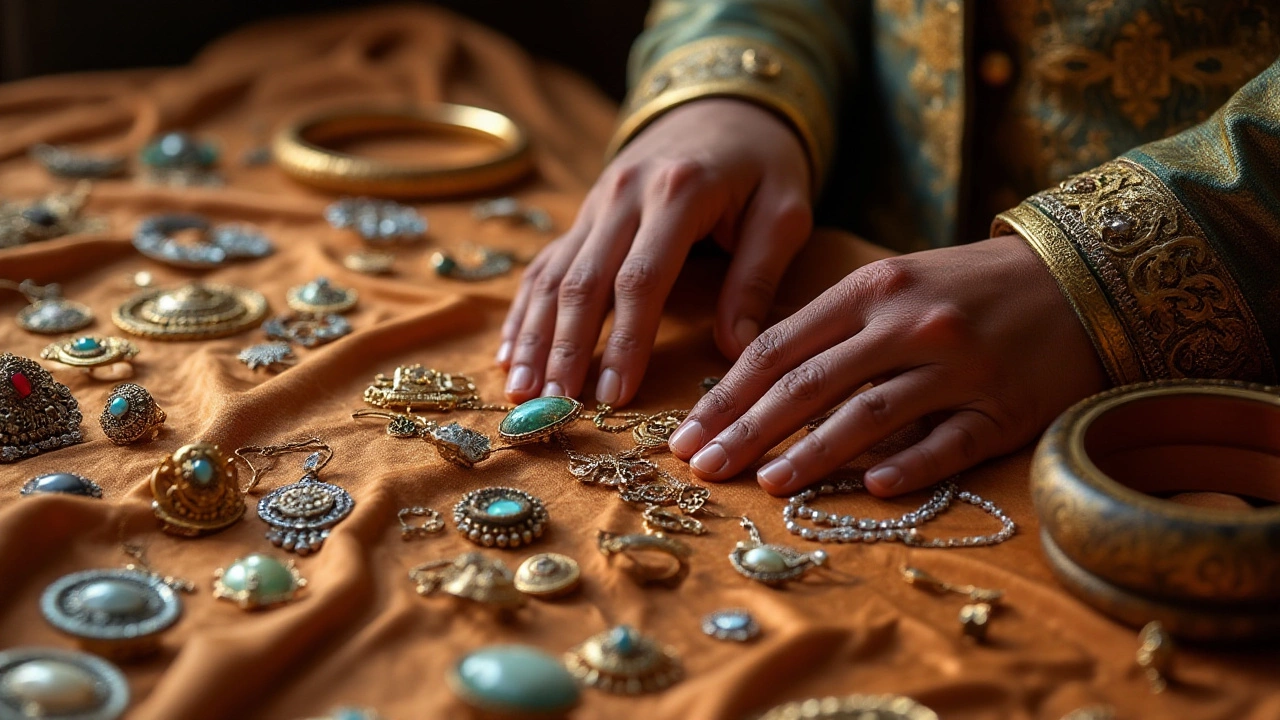
Gemstones and Their Rising Worth
Diving into the radiant world of gemstones unearths a treasure trove of potential investments. These luminous beauties are carved by nature and cherished by people across centuries. Among them, certain gemstones have steadily climbed the ladder of value, proving themselves as more than mere adornments. Notably, natural rubies, sapphires, and emeralds have caught the eyes of collectors and investors alike. With their bold colors and luxurious allure, these stones stand as enduring symbols of wealth and prestige, with a trend towards appreciation that shows no signs of waning.
The intrinsic value of a gemstone is often dictated by its rarity, color, and clarity, turning even a small, vibrant stone into an object of desire. Consider the ruby, revered for its captivating red hue, often referred to as the 'king of gemstones.' When unblemished and possessing a vivid color, rubies from regions like Myanmar command astronomical prices. Similarly, sapphires, known for their intense blue shades, have witnessed substantial price hikes over the years, driven by demand from Asia and beyond. Each gemstone carries its own story and attracts attention not just for its beauty, but for the tales of distant lands and ancient traditions it embodies.
In a world hungry for stories captured in stone, emeralds hold a place of special reverence. Legendary for their lush, verdant color, which no modern process can quite replicate, they symbolize renewal and vitality. Colombia has been the traditional source of choice, providing stones so magnificent that their allure transcends both time and geography. These gems often have inclusions, known as 'jardin,' which, rather than diminishing their value, add a natural charm unique to each piece.
Gem expert Richard Hughes once noted, "Inclusions in emeralds are like tiny gardens, symbolic of the emerald's life force and sought after for their uniqueness."
The surge in interest for colored gemstones has not only revived traditional markets but has also invited a wider audience into the fold, eager to explore investment opportunities. The past decade has seen an increase in auctions dominated by colored stones, with prices sometimes surpassing those traditionally fetched by diamonds. This shift is largely fueled by a desire for rarity and the unique stories behind each gem. It's a reminder that, while fashion may wax and wane, the innate beauty and scarcity of certain gemstones ensure they remain both a tactile delight and a valuable asset.
As for the future, those in the know anticipate that contemporary collectors will continue to drive demand, not just for the aesthetics of these stones but for their investment potential. With increasing environmental and ethical scrutiny, gemstones with verified origins and conflict-free guarantees are likely to see even more appreciation. Investing in antique jewelry enriched with these stones becomes a dual act of preserving history and betting on the flair of nature's unparalleled artistry.
Timeless Designs that Captivate
When it comes to antique jewelry, certain timeless designs stand out, not just for their aesthetic appeal but for their enduring market value. From the smooth elegance of the Art Nouveau period to the geometric precision of Art Deco pieces, these styles continue to captivate collectors and investors alike. The fluid lines and natural motifs of the Art Nouveau era, for example, evoke a sense of grace and harmony that remains fashionable across generations. Jewelry from this period often features delicate enamel work and nature-inspired themes, making each piece a unique artifact of artistic expression.
Delving into the world of Art Deco, the focus shifts to bold geometry and rich color contrasts. This design movement, traditionally stretching from the 1920s to the 1930s, reflects an era of innovation and exuberance. The strong angles, symmetry, and use of vibrant gemstones like emeralds and sapphires make these pieces highly sought after. A notable fact is that the Art Deco influence has often reemerged in modern designs, a testament to its lasting impact on fashion. These designs resonate with today's collectors, marrying classic aesthetics with modern tastes, ensuring their enduring popularity.
Heritage and Craftsmanship
One cannot discuss antique jewelry without acknowledging the significance of craftsmanship and heritage in its value. Such jewelry is often meticulously handcrafted, with techniques passed down through generations. These pieces frequently carry the hallmark of their time, encapsulating both the cultural and economic conditions of their era. Recently, certain elegant Victorian sets have fetched remarkably high prices at auctions, demonstrating how attention to detail can increase value tremendously.Collectors pay premium prices for pieces with profound historical connections or those crafted by prestigious houses like Cartier or Tiffany & Co. These names assure buyers of quality and legacy, often reflected in a piece's value. A quote from a leading expert in antique jewelry, Dr. Alexandra Rhodes, frames this well:
"The allure of antique jewelry lies not just in its beauty but in the stories it holds – each piece is a testament to the innovation and artistry of its time."Indeed, the intricate details and the artisanship engraved into these pieces make them more than just decorative; they are tangible slices of history.
While the styles are varied, from the minimalistic elegance of mid-century designs to the opulent flourishes of Baroque times, each holds a unique charm. Vintage cocktail rings, encrusted with semi-precious stones, eyeliner-popping chokers detailed with intricate lacework, or charming lockets oftentimes embedded with portraits or hair mementos, speak to personal tastes and stories yet untold. Each piece stands as a testament to its era's distinct design ethos, proving why these timeless antiques continue to increase in value appreciation. Collecting them is not only an investment in aesthetics but also a securing of cultural heritage, a personal connection to artistry across time.
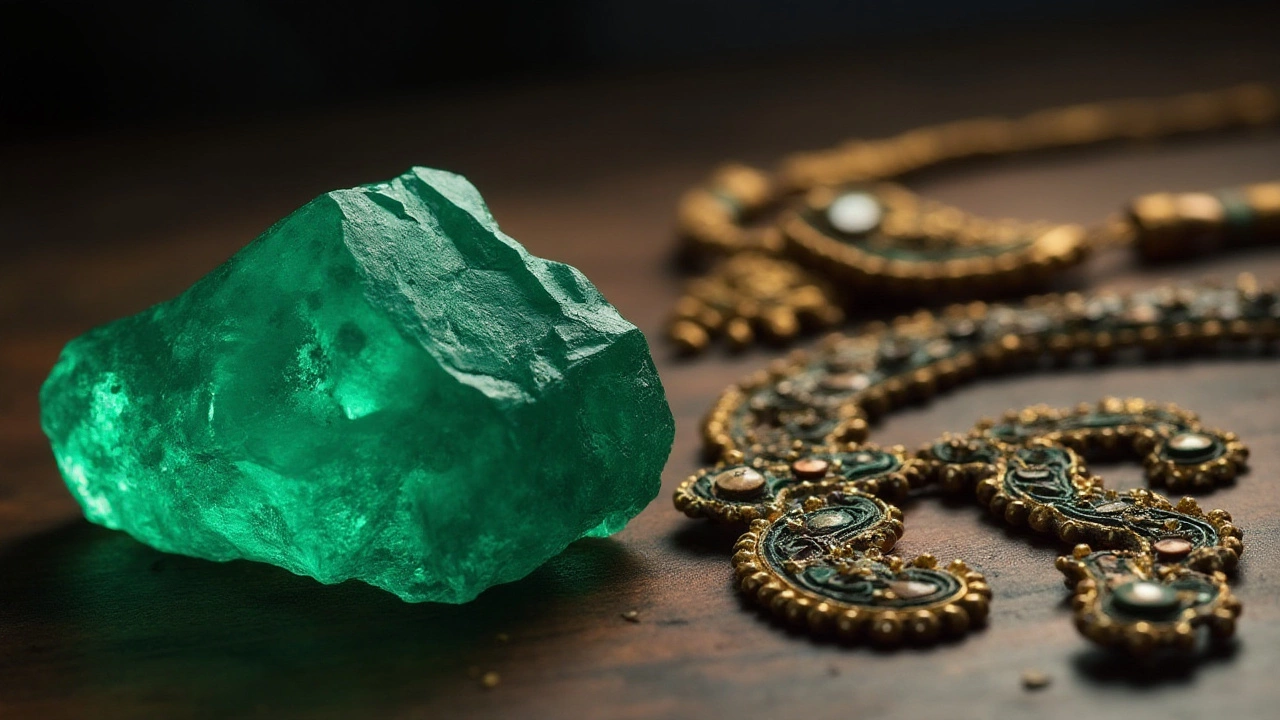
Market Trends and Future Investments
In the world of antique jewelry, understanding market trends is like having a treasure map. These trends often dictate the value trajectory of certain pieces, making them either cherished collectibles or astute investments. Recently, there has been a noticeable shift towards more unique, one-of-a-kind antique jewelry pieces that tell a story. Buyers are increasingly attracted to items that not only boast historical significance but also reflect the intricate craftsmanship of bygone eras. As global uncertainty continues to affect traditional investment vehicles, many are turning to the tangible and enduring value of these exquisite adornments.
The 2020s have shown a burgeoning interest in bold, statement jewelry, with Art Deco and Art Nouveau styles gaining momentum. These styles, characterized by geometric shapes and intricate detailing, reflect a period when artisans experimented with daring designs and vibrant colors. Investors are particularly keen on these pieces, as they often feature unusual gemstones that are seeing a rise in demand and value. From delicate filigree to bold enamel work, these intricate designs are sought after not just for their aesthetic appeal but for their ability to capture the zeitgeist of their respective eras.
Then there's the enduring allure of gemstones. Natural stones, especially those that are untreated and rare in color, are consistently valued by collectors. A recent study highlighted that untreated Burmese rubies and Kashmir sapphires have appreciated significantly over the last decade. Such gems, when set in historically significant pieces, command premium prices at auctions and private sales. It's noteworthy that auctions at major houses like Christie’s and Sotheby’s have seen record-breaking sales of antique jewelry, underscoring the robust interest in these timeless treasures.
"The antique jewelry market is not just about the piece itself, but the story it tells," said Elizabeth Wilson, a renowned vintage jewelry historian. "Collectors are investing in these pieces not only for their beauty but for their cultural and historical significance."
Looking forward, several trends are anticipated to influence the antique jewelry market. There is a growing focus on sustainability, with many collectors preferring pieces that are ethically sourced and crafted. This has bolstered the popularity of Victorian and Edwardian jewelry, which often features recycled materials and exquisite craftsmanship. Moreover, the rise of digital auction platforms has opened the market to new generations of collectors who appreciate the convenience and transparency of online bidding, allowing them access to a broader selection of historic jewelry pieces.
The future of antique jewelry investments seems promising, with savvy investors leveraging the growing demand for authenticity and rarity. As public appreciation for fine jewelry continues to grow, collectors are advised to stay informed about market dynamics and emerging trends that may influence valuations. For those with the insight to predict these market inclinations, antique jewelry not only holds a place of pride in their collection but also represents a lucrative investment opportunity.

